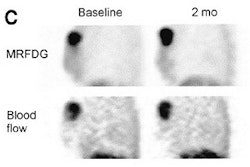(Radiology Review) Around half of clinically occult breast carcinomas are characterized by microcalcifications, according to a study by Dr. Paul Stomper and colleagues at the State University of New York, Buffalo.
The group assessed the mammographic predictors of invasive carcinomas, associated with malignant lesions with microcalcifications, that show no discreet mass. "Mammographic calcifications associated with malignancy are usually found within ducts and lobules containing ductal carcinoma in situ (DCIS). In general, 26%-38% of biopsy-proven malignant microcalcification lesions without a mass also contain an associated focus or foci of invasive carcinoma," they reported.
An improved understanding of the risk and size of invasive carcinomas encountered with DCIS microcalcifications would provide better patient management, according to the authors. For example, patient counseling would be more specific, and patient selection for sentinel node biopsy would be improved, they wrote in the American Journal of Roentgenology.
They study results showed that 65% of women studied had pure DCIS, 32% had DCIS with a focus of invasion, and 4% only had invasive carcinoma. The authors determined larger calcifications (11 mm or greater) had a higher association with invasive foci (40%) compared with calcifications less than 11 mm (26%). Also, linear calcifications had a higher association with invasive foci (44%) compared with granular calcifications (29%).
"Only 11% of cancers characterized by fine granular calcifications were associated with invasion as compared with 32% of those with coarse and mixed granular calcifications," they reported.
In assessing lesion size, they found 65% of the invasive carcinomas were 10 mm or less at surgery. Twenty-one percent of invasive carcinoma specimens measured 2-5 mm, and 23% were 1 mm or less.
"There were no significant differences in these size distributions of associated invasive carcinomas when comparing mammographic calcification extents of 1-10 mm and 11 mm and greater," they wrote. "Mammographic calcification features of malignant lesions cannot predict the absence of invasion with greater than 90% predictive value or predict the presence of invasion with greater than 45% predictive value," they concluded.
Mammographic predictors of the presence and size of invasive carcinomas associated with malignant microcalcification lesions without a mass
Paul Stomper, et. al.Department of diagnostic Imaging, Roswell Park Cancer Institute, School of Medicine and Biomedical Sciences, Buffalo, NY
AJR 2003 December; 181:1679-1684
By Radiology Review
January 16, 2004
Copyright © 2004 AuntMinnie.com


















